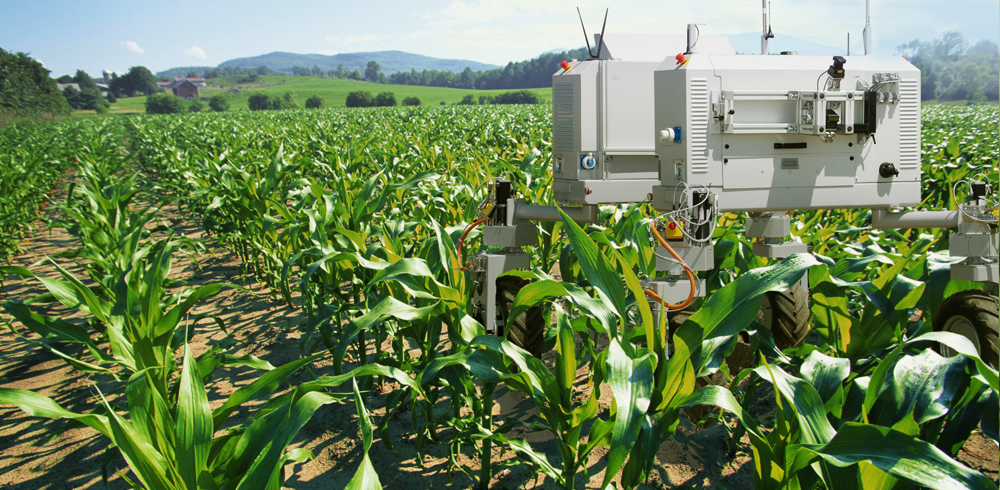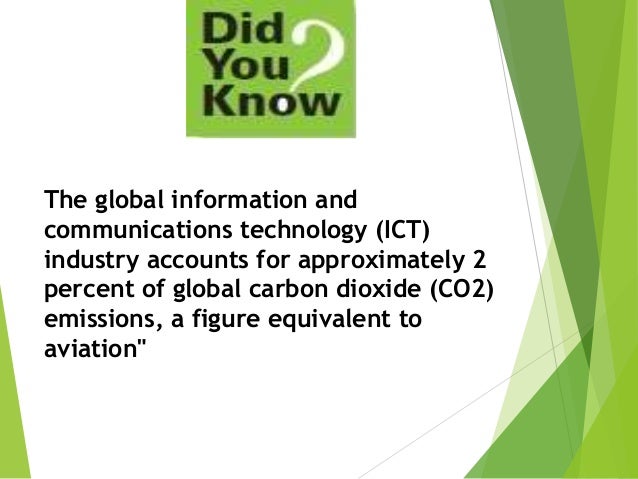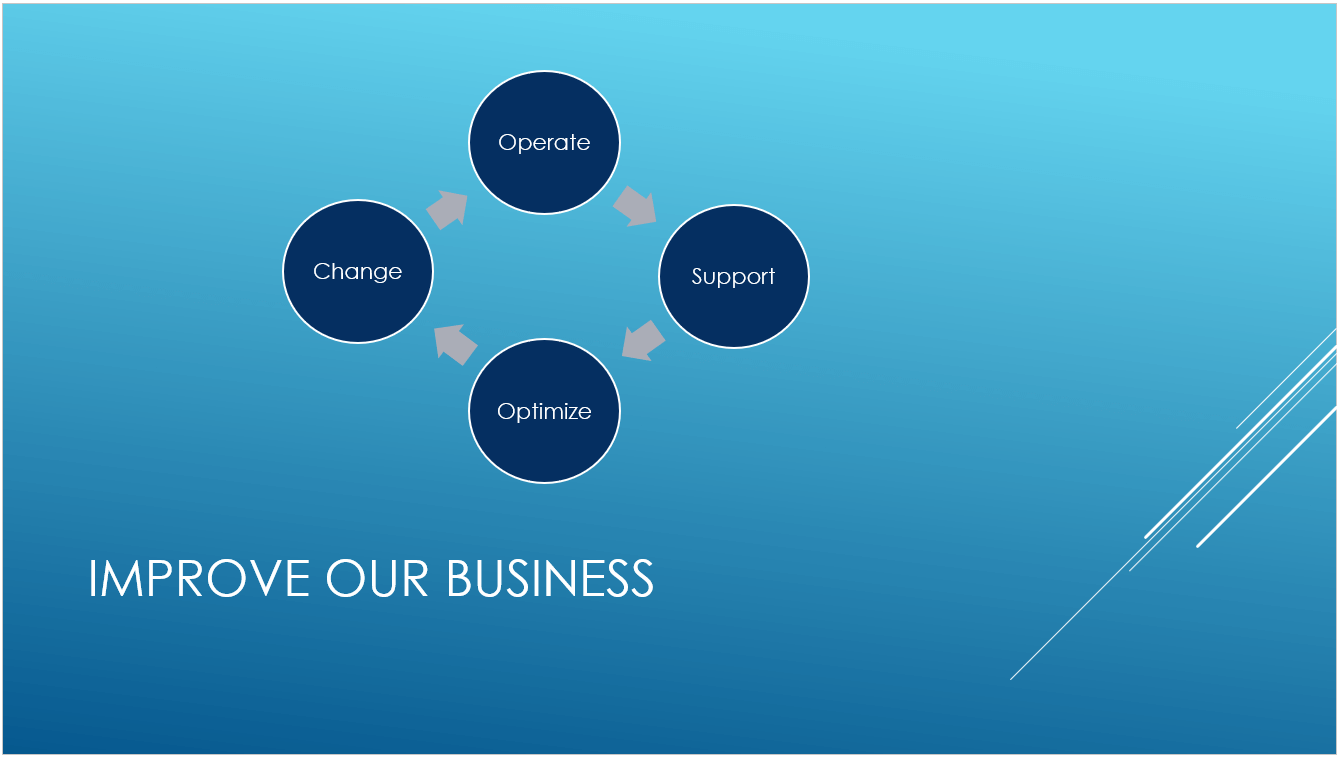Green Ict Benefit Ppt
BENEFITS OF GREEN ICT IMPLEMENTATION IN EDUCATION SECTOR The main motivation for implementing Green ICT is to reduce costs. Actions to minimize the environmental impacts of ICT use can help the education institutions in some of the benefits - appealing to all stake holder groups: faculty, student and staff satisfaction increases, the institute. Green information technology (green IT) is an. Emerging discipline and issues related with this are of growing concern for the. Business, social and environmental impact in the 21st century. Another definition for Green IT says, it is the “optimal use of information and communication technology (ICT) for managing the environmental sustainability of enterprise operations and the supply chain, as well as that of its products, services, and resources, throughout their life cycles.”(The Gartner report, “Green IT: The New Industry Shock Wave,” by analyst Simon Mingay). Green computing is about reducing the environmental footprint of computers or of ICT in general. This is most commonly achieved by:. making data centers and computing devices more energy efficient,. using more renewable energy sources,. using l. For assessing the ICT carbon footprint. Basis of methodology is to compare the GHG emissions from a Business as Usual (BAU) scenario and a scenario which includes the ICT service. Must be carried out over the full life cycle (LCA). Helps to establish the business case to go green.
Part two of a two-part series...
While part one focused on the opportunities inherent in green practices that lead to reduced energy consumption and lower utility bills, part two identifies means of increasing green adoption in the face of barriers both perceived and real.
Green IT: Barriers Versus Benefits
While Green IT is a game changer in addressing environmental problems facing us and there is growing support for adoption of green initiatives, there are barriers – both perceived and real – to implementing green technologies and measures. But that doesn't mean we should abandon our green efforts; instead we should identify real barriers and address them to realize the benefits.
Table 1 highlights the major barriers as well as the benefits of greening IT. Often the cost of implementing green IT and other green initiatives is seen as major stumbling block. Though there will be capital cost associated with required additional hardware or software, replacing existing hardware with greener IT products or new software for IT-enabled green initiatives, over a period of time enterprises can see net savings. And the green initiatives could be carried out in a phased manner, initially focusing on low-hanging fruits that don't require major investments.
As highlighted earlier in the article, greening by IT might call for reengineering of business processes and practices, which in some instances, could be a major challenge that enterprise had to address holistically. Several studies reveal that reluctance to change as another key barrier. Stakeholder involvement and engagement with enterprise green initiatives from early on addressing their fears and convincing them on the need for going green will help to overcome or minimize this barrier.
Potential lack of alignment between Green IT and enterprise green initiatives is an issue as it wouldn't yield fuller benefits of green efforts. Business executives should, therefore, develop business, IT, and environmental sustainability (BITES) strategies for their business enterprises that are aligned with each other. This nexus is the key to the successful realization of their business goals and the fulfillment of their environmental and social responsibilities.

As briefly summarized in Table 1, benefits of judiciously implementing green IT initiatives are many, and the benefits have to be assessed in the business context. The adoption of green technologies and initiatives will be driven by a strong business case. Several case studies confirm the realization of several benefits. The energy and cost savings more than compensate for the upfront cost associated with the implementation of green IT as well as other burden. Businesses also need to look at green requirements from another viewpoint. The implications of not going green might cost a lot in the context of emerging stricter environmental regulations, stakeholder demands, competitiveness, brand or corporate image and social responsibility.

In an interesting development, as a recent HBR blog highlights, a new study reveals sustainability is an increasingly important factor in attracting and managing talent. Employees also want to be involved in developing sustainability strategy. Half of younger employees, about one-fifth of older employees and three-quarters of enthusiasts expect to play a role in how their firms approach the topic.
Green Prospects
Though IT has to become greener, as the Smart 2020 and Smarter 2020 reports pointed out, ICT's largest influence will be in enabling energy efficiencies, minimizing resource consumption and reducing environmental impact in all other sectors and areas. New technologies and systems such as RFID (radiofrequency identification), Internet of Things, sensor networks, smart phones, ubiquitous computing, cloud computing, context-aware systems, environmental intelligence and smart systems present new opportunities to address resource (energy and water) consumption and improve environmental sustainability.
Green Action Agenda
Unsustainable environments make societies vulnerable, and can severely impact the future progress of the society – growth of the economy, business and societal well being. Sustainable innovation – innovation that is inspired by and built on a vision to cater to economical, environmental and societal needs (triple bottom line) – is one of the most meaningful and lasting contributions that we as individuals and businesses, supported by the government, can make. Future of our planet and the society is in our hands and what we do today to address environmental issues will not only shape our future but also our future generations.
IT professionals, educators, researchers, and businesses can make a difference by harnessing IT's power to create a sustainable environment for the benefit of current and future generations. Smart companies are adopting innovative environmental strategies to innovate, create value, and build a competitive advantage.
Enterprises and individuals can – and should – work both independently and collaboratively to accelerate the adoption of green IT and help speed the world's transition to a low-carbon economy. As Albert Einstein once said, 'The significant problems we have cannot be solved at the same level of thinking with which we created them.' To build a greener environment, you must modify or end many old and familiar ways of doing things and discover new methods.
Helpful Resources for Further Information
For a comprehensive overview on Green IT, refer to book chapter, 'Green IT: An Overview,' in the new book Harnessing Green IT: Principles and Practices, San Murugesan and GR Gangadharan (Editors), Wiley-India and IEEE Computer Society, 2012 – free download.
For information on how IT could be harnessed in other key sectors to green their operations, refer to the report, SMARTer 2020: The Role of ICT in Driving a Sustainable Future, Global e-Sustainability Initiative (GeSI), 2013.
© Author: San Murugesan
About the Author
San Murugesan is director of BRITE Professional Services, and an Adjunct Professor in the School of Computing and Mathematics at the University of Western Sydney, Australia. His expertise and interests include cloud computing, green computing, Web 2.0 and 3.0, and IT in emerging markets. He offers training programs on cloud computing and green IT, and delivers keynotes and seminars. His recent book, Harnessing Green IT: Principles and Practices, co-edited with GR Gangadharan, is well recognized in professional and academic circles and is being adopted as textbook for courses on green IT, green computing and green business. He is Associate Editor in Chief of the IEEE’s IT Professional magazine and Editor of Computer. He edits the new 'Cloud Cover' column in Computer and 'IT in Emerging Markets' column in IEEE IT Professional (short articles for both these columns are welcome). He is a fellow of the Australian Computer Society, Senior Member of IEEE and a distinguished visitor of the IEEE Computer Society. Dr. Murugesan held various senior positions in academia and industry in Australia, USA and India. Contact him at san1[at]internode[dot]net or connect with him on Twitter @santweets, or LinkedIn.
Advantages of Green Technology | Disadvantages of Green Technology
This page covers advantages and disadvantages of Green Technology.It mentions Green Technology advantages or benefits and Green Technology disadvantages or challenges.
Introduction:
The technology which builds products and systems to help inconserving natural resources and environment is known as greentechnology.

It is technology which is environment friendly and hence known asenvironmental technology or clean technology.It uses innovative methods to create environmental friendly products.
The need of green technology arises due to the fact that naturalresources are declining and pollution has increased due to abundantuse of non renewable sources.
Products, systems or equipments based on green technology satisfyfollowing features or characteristics.
• It should reduce or minimize degradation of natural environment around us.
• It should have zero or minimum emission of green housegases.
• It should be safe to use and should promote healthy environmentfor all the forms of life including humans, birds, animals etc.
• It should help in conservation of energy as well asnatural resources such as solar, water, wind etc.
• It should promote use of re-newable resources.
The figure-1 mentions goals or functions of green technology.They are reduce (fuels, waste, energy consumption etc.), recycling (of paper, plastic, can,batteries, clothing etc.) , renewing (renewing energysuch as wind power, water power, solar energy, bio-fuel, waste water etc.), Refuse (the useof plastic bags) and responsibility.
Here term 'responsibility' refers to following responsibilities by the people ofour nation:
• Do not waste electricity i.e. switch off electrical equipment when not needed.
• Do not waste water i.e. never leave taps open while brushing teeth or washingplates.
• Do not waste fuel.
• Do not waste food.
The major applications of green technology include following.
• Energy sector
• Building sector
• Water and waste management sector
• Transport sector
• Solar power sector
Benefits or advantages of Green Technology
Following are the advantages of Green Technology:
➨It does not emit anything harmful forthe environment.
➨It has become popular as consumers of the technologyare becoming more environment conscious.This will give benefits to investors at long run in certain areas.
➨It requires less cost for maintenance. This reduces operating costand hence overall cost on the long run.
➨As it uses renewable natural resources and hence we will never run out of vitalresources such as water and electricity.
➨It will slow down effects of global warming due toreduction in CO2 emissions.
Challenges or disadvantages of Green Technology
Green Ict Benefit Ppt Free
Following are the disadvantages of Green Technology:
➨Initial investment or implementation cost is very high.
➨People are still not familiar with the technology andhence will take time to adopt it for larger population.
➨The technology is still evolving and many of theproducts are at R&D stage. Hence people are unaware ofperformance results.
➨Lack of skilled human resources are availableto install or implement the green technology based products orsystems.
➨In most of the countries policies have not been finalized forthe green technology based systems.
Benefits Of Ict In Healthcare
Advantages and Disadvantages of other wireless technologies
What is Difference between
difference between OFDM and OFDMA
Difference between SC-FDMA and OFDM
Difference between SISO and MIMO
Difference between TDD and FDD
FDMA vs TDMA vs CDMA
FDM vs TDM
CDMA vs GSM
